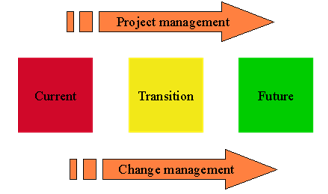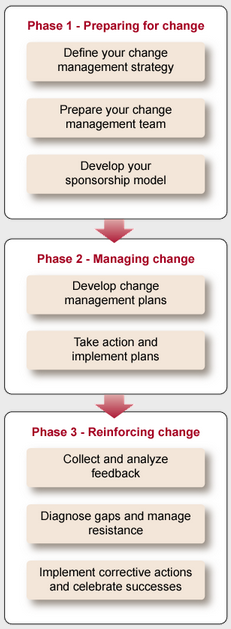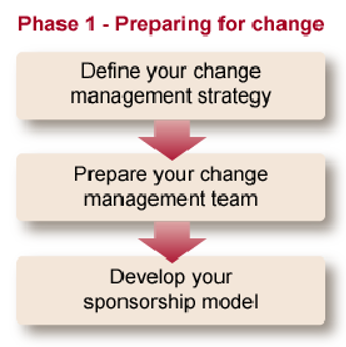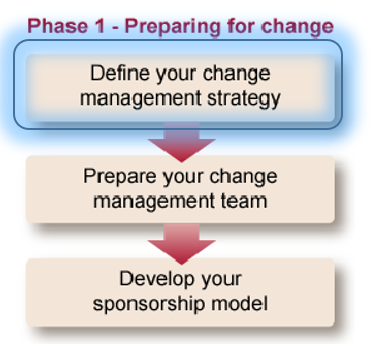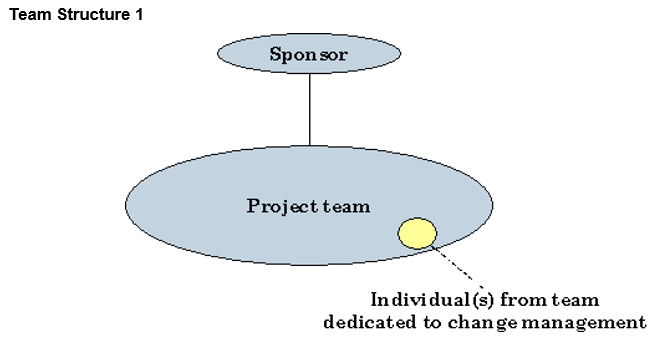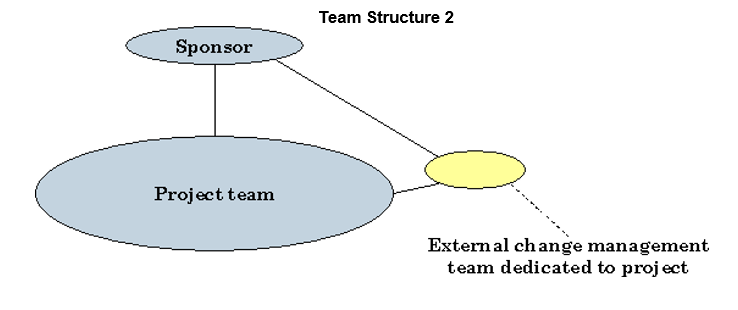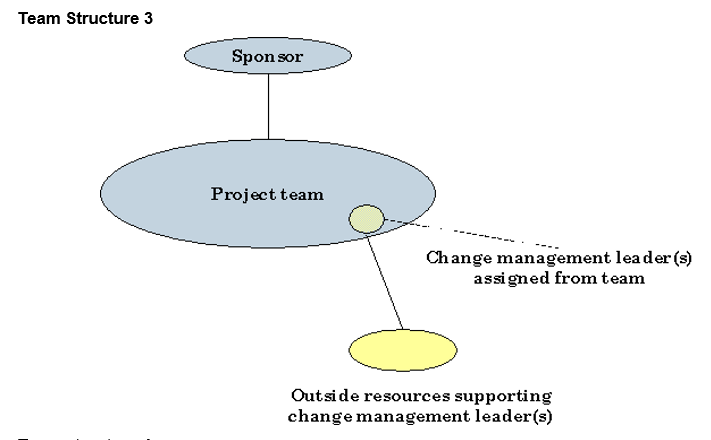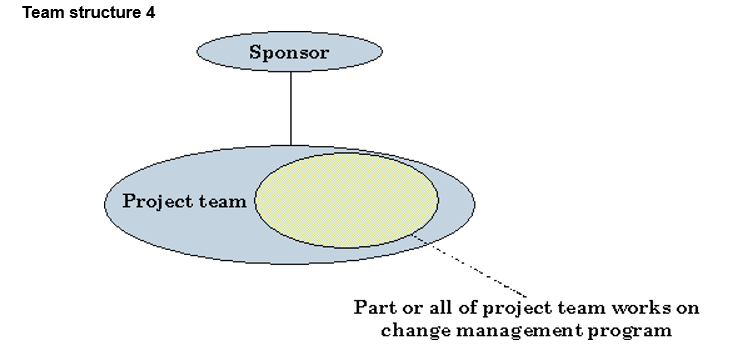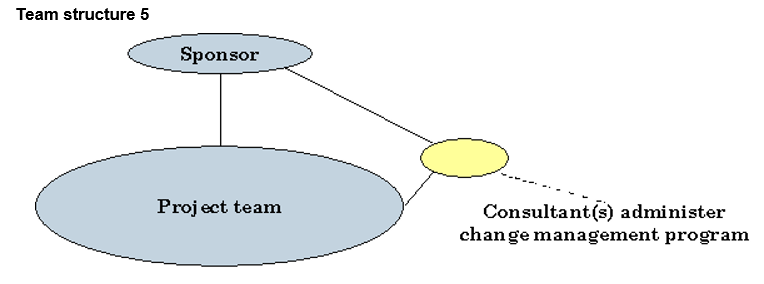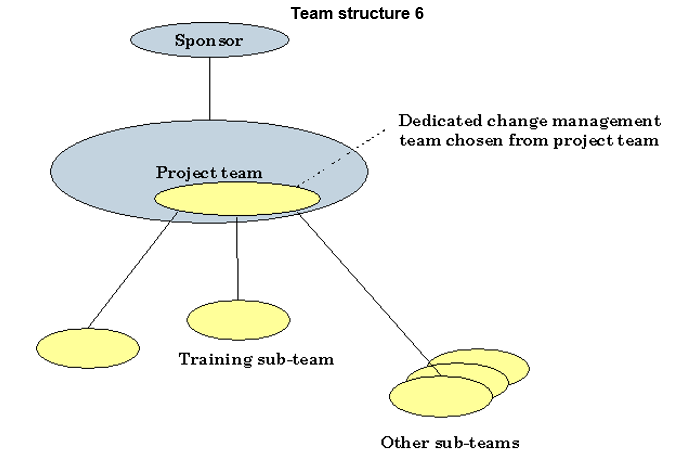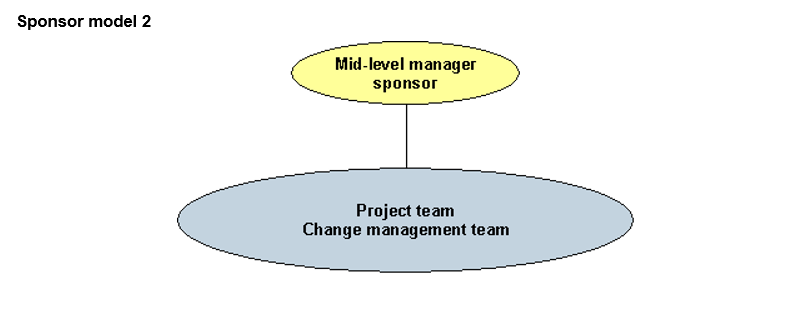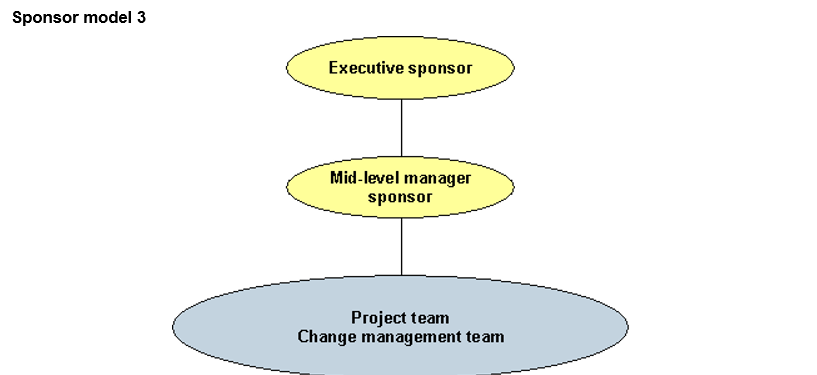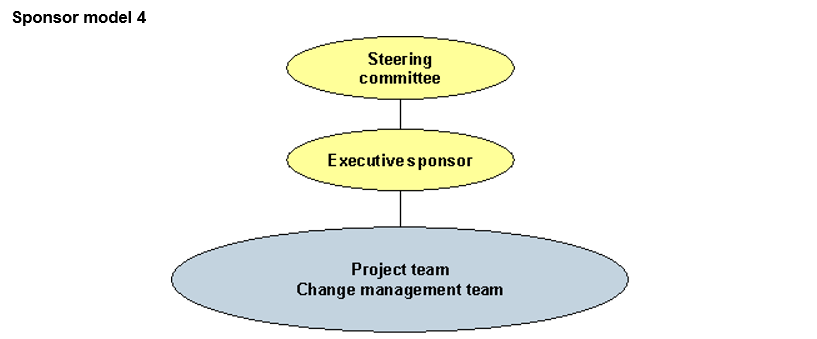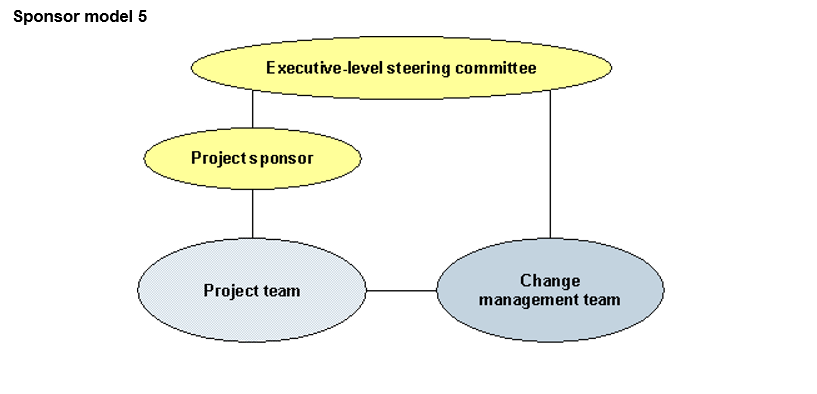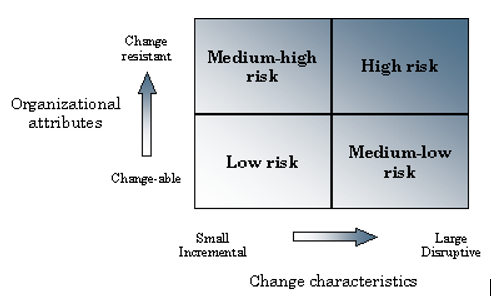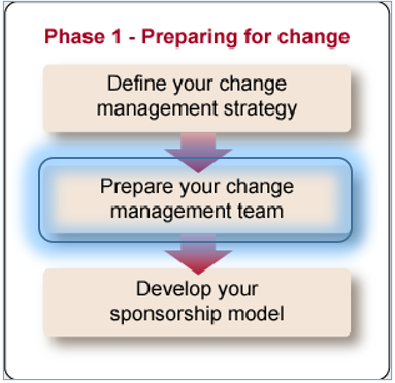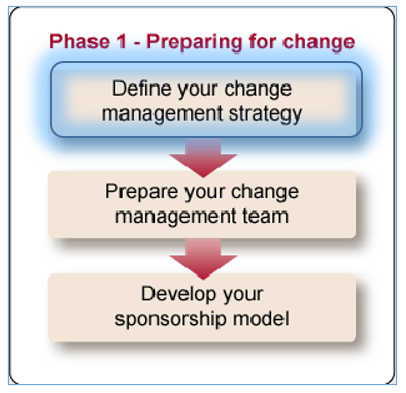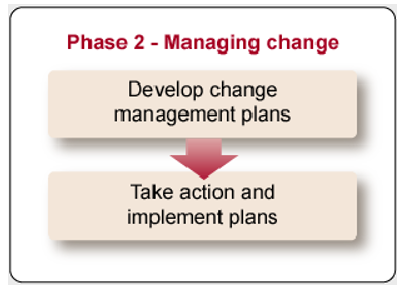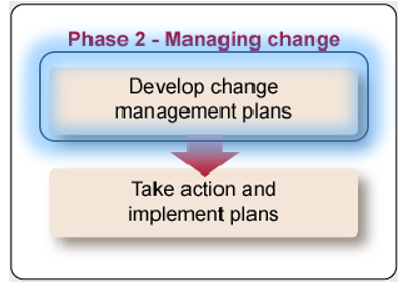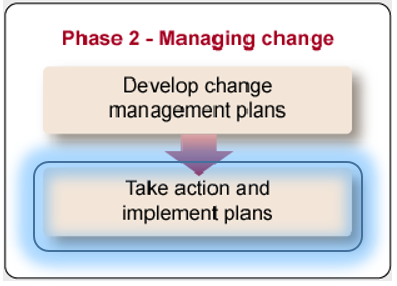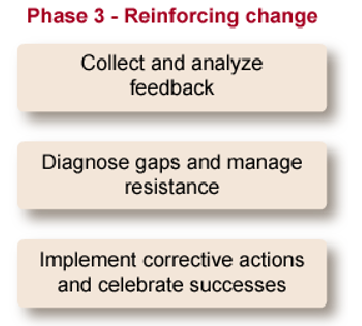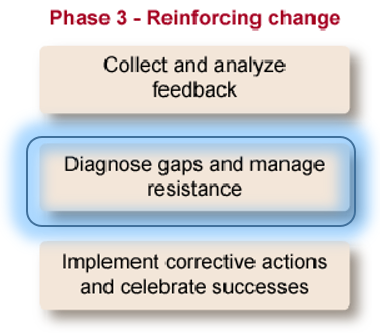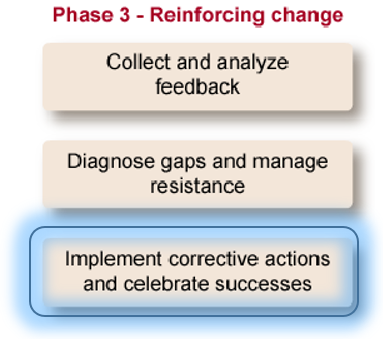Difference between revisions of "Change Management"
| (3 intermediate revisions by the same user not shown) | |||
| Line 1,687: | Line 1,687: | ||
=== Change Characteristics Assessment === | === Change Characteristics Assessment === | ||
Mark your location on the following spectrum. If you fall on the right of the spectrum, your project will require more change management resources and activities than if you fall on the left of the spectrum. This assessment result will be used to customize your change management strategy and activities. Record your assessment score. | Mark your location on the following spectrum. If you fall on the right of the spectrum, your project will require more change management resources and activities than if you fall on the left of the spectrum. This assessment result will be used to customize your change management strategy and activities. Record your assessment score. | ||
| + | |||
| + | Yopu can download the Excel file [[:File:Adkar - Change Characteristics Assessment.xlsx|here]]. | ||
<br> | <br> | ||
:[[File:Scope of change.png]] | :[[File:Scope of change.png]] | ||
| Line 1,705: | Line 1,707: | ||
=== Change Characteristics Worksheet === | === Change Characteristics Worksheet === | ||
This high-level worksheet will help you think about the change you are implementing. After completing the worksheet, you will complete a Change Characteristics Assessment that will be a guide for developing your change management strategies and actions. | This high-level worksheet will help you think about the change you are implementing. After completing the worksheet, you will complete a Change Characteristics Assessment that will be a guide for developing your change management strategies and actions. | ||
| + | |||
| + | You can download the Excel file [[:File:Adkar - Change Characteristics Worksheet.xlsx|here]]. | ||
'''Scope of change'''<br> | '''Scope of change'''<br> | ||
| Line 1,763: | Line 1,767: | ||
=== Organizational Attributes Assessment === | === Organizational Attributes Assessment === | ||
Mark your location on the following spectrum. If you fall on the right of the spectrum, your project will require more change management resources and activities than if you fall on the left of the spectrum. This assessment result will be used to customize your change management strategy and activities. Record your assessment score. | Mark your location on the following spectrum. If you fall on the right of the spectrum, your project will require more change management resources and activities than if you fall on the left of the spectrum. This assessment result will be used to customize your change management strategy and activities. Record your assessment score. | ||
| + | |||
| + | You can download the Excel file [[:File:Adkar - Organizational Attributes Assessment.xlsx|here]]. | ||
Perceived need for change among employees and managers | Perceived need for change among employees and managers | ||
Latest revision as of 15:49, 21 April 2021
| Source: | DataSource |
|---|---|
| Language: | English |
| Topic: | Change Management |
| SubTopic: | ADKAR |
| Last Edit By: | DochyJP |
| LastEdit: | 2021-04-21 |
| Document type: | Training |
| Status: | Active |
| Access: | free |
Introduction
What is Change Management
Context and objectives
When introducing a change to the organization, we are ultimately going to be impacting one or more of the following four parts of how the organization operates:
- Processes
- Systems
- Organization structure
- Job roles
While there are numerous approaches and tools that can be used to improve the organization, all of them ultimately prescribe adjustments to one or more of the four parts of the organization listed above. Change typically results as a reaction to specific problems or opportunities the organization is facing based on internal or external stimuli. While the notion of 'becoming more competitive' or 'becoming closer to the customer' or 'becoming more efficient' can be the motivation to change, at some point these goals must be transformed into the specific impacts on processes, systems, organization structures or job roles. This is the process of defining 'the change'.
Ultimately, the goal of change is to improve the organization by altering how work is done.
Change Management vs Project Management
However, it is not enough to merely prescribe 'the change' and expect it to happen - creating change within an organization takes hard work and structure around what must actually take place to make the change happen. To begin, lets look at the formal definitions of project management and change management - two key disciplines required to bring a change to life. These are two commonly accepted definitions that help us begin to think about these two distinct but intertwined disciplines.
- Project Management : Project management is the application of knowledge, skills, tools and techniques to project activities to meet project requirements.
Project management is accomplished through the application and integration of the project management processes of initiating, planning, executing, monitoring and controlling, and closing.
From PMBOK® Guide, Third Edition
- Change management : Change management is the process, tools and techniques to manage the people-side of change to achieve the required business outcome. Change management incorporates the organizational tools that can be utilized to help individuals make successful personal transitions resulting in the adoption and realization of change.
As shown in the figure above, both project management and change management support moving an organization from a current state (how things are done today), through a transition state to a desired future state (the new processes, systems, organization structures or job roles defined by 'the change'). Project management focuses on the tasks to achieve the project requirements. Change management focuses on the people impacted by the change.
Any change to processes, systems, organization structures and/or job roles will have a 'technical' side and a 'people' side that must be managed. Project management and change management have evolved as disciplines to provide both the structure and the tools needed to realize change successfully on the technical and people side.
| Discipline | Process | Tools |
|---|---|---|
| Project management |
|
|
| Change management |
|
|
Separate but integrated in practice
So far project management and change management have been discussed as two distinct disciplines. While separate as fields of study, on a real project change management and project management are integrated. The steps and activities move in unison as teams work to move from the current state to a desired future state.
As an example, think about what activities occur during the planning phase of a project:
On the project management side, teams are identifying the milestones and activities that must be completed. They are outlining the resources needed and how they will work together. They are defining the scope of what will be part of the project and what will not be.
From a change management side, teams begin crafting key messages that must be communicated. They work with project sponsors to build strong and active coalitions of senior leaders. They begin making the case of why the change is needed to employees throughout the organization, even before the specific details of the solution are complete. The most effective projects integrate these activities into a single project plan.
Summary
| Element | Goal or objective |
|---|---|
| "The change" | To improve the organization in some fashion - for instance reducing costs, improving revenues, solving problems, seizing opportunities, aligning work and strategy, streamlining information flow within the organization |
| Project management | To develop a set of specific plans and actions to achieve "the change" given time, cost and scope constraints and to utilize resources effectively (managing the 'technical' side of the change) |
| Change management | To apply a systematic approach to helping the individuals impacted by "the change" to be successful by building support, addressing resistance and developing the required knowledge and ability to implement the change (managing the 'people' side of the change) |
Change Management Process
Change Management Strategy
The change management strategy defines the approach needed to manage change given the unique situation of the project or initiative.
Situational awareness
- Change characteristics - Understanding the characteristics of the change requires you to answer questions like:
- What is the scope of the change?
- How many people will be impacted?
- Who is being impacted?
- Are people being impacted the same or are they experiencing the change differently?
- What is being changed - processes, systems, job roles, etc?
- What is the timeframe for the change?
- Organizational attributes are related to the history and culture in the organization and describe the backdrop against which this particular change is being introduced.
- What is the perceived need for this change among employees and managers?
- How have past changes been managed?
- Is there a shared vision for the organization?
- How much change is going on right now?
- Impacted groups - Developing a map of who in the organization is being impacted by the change and how they are being impacted. Outlining the impacted groups and showing how they will be impacted enables specific and customized plans later in the change management process.
Supporting structure
- The change management team structure identifies who will be doing the change management work. It outlines the relationship between the project team and the change management team. The most frequent team structures include
- change management being a responsibility assigned to one of the project team members or
- an external change management team supporting a project team.
The key in developing the strategy is to be specific and make an informed decision when assigning the change management responsibility and resources.
- The sponsor coalition describes the leaders and managers that need to be on-board for the change to be successful. Starting with the primary sponsor, the sponsor model documents the leaders of the groups that are being impacted by the change. The change characteristics will determine who must be part of the coalition. Each member of the sponsor coalition has the responsibility to build support and communicate the change with their respective audiences.
Strategy analysis
- Risk assessment - The risk of not managing the people side of change on a particular change is related to the dimensions described in the situational awareness section. Changes that are more 'dramatic' and father reaching in the organization have a higher change management risk. Likewise, organizations and groups with histories and cultures that resist change face higher change management risk. In developing the strategy, overall risk and specific risk factors are documented.
- Anticipated resistance - Many times, after a project is introduced and meets resistance, members of the team reflect that "they saw that reaction coming." In creating the change management strategy, identify where resistance can be expected.
- Are particular regions or divisions impacted differently than others?
- Were certain groups advocating a different solution to the same problem?
- Are some groups heavily invested with how things are done today?
Note particular anticipated resistance points depending on how each group is related to the change.
- The identification of any special tactics that will be required for this particular change initiative. The special tactics formalize many of the learnings from the strategy development related to the change and how it impacts different audiences in the organization. Throughout the change implementation, special tactics may need to be revisited and updated
What's next
Formulating the change management strategy is the first critical step in implementing a change management methodology. The strategy provides direction and results in informed decision making throughout the change process. A well-formulated strategy really brings the project or change to life, describing who and how it will impact the organization.
The change management strategy also contributes to formulation of the rest of the change management plans. For instance, the groups identified in the strategy should each be addressed specifically in the communication plan. Steps for building and maintaining the coalition identified in the strategy are part of the sponsorship roadmap. Each of the subsequent change management plans and activities are guided by the findings in the change management strategy.
| Change management strategy | Change management plan |
|---|---|
|
|
Projects meet their objectives when they manage the human side of change effectively.
A robust change management strategy sets the stage for effective change management and project success.
Prepare for change
Preparing for change deliverables: In Phase 1, Preparing for change, you will produce the following deliverables:
- Size of the change (assessment)
- Organization attributes (assessment)
- High-level change management strategy
- Ready and able change management team
- Prepared sponsors and a sponsorship model
In Phase 2, you will develop change management plans based on this overall change management strategy.
Define your change management strategy
Identifying Change Characteristics
Why? This sizing exercise will help you understand how much change management support will be required and will help you scale the change management approach accordingly. Specifically, for each sizing characteristic your change management strategy will require adjustment. When beginning the change management project, one of the most important steps you can take is to understand the nature of the change. The worksheet and assessment tool in this step will help you understand the type of change, the size of the change, whose impacted (and who's not), the number of impacted employees and other critical scope questions.
Each change in your organization will be unique. As a result, the magnitude of the change management activities, the required sponsorship and your overall team structure will be unique as well. Sizing the change is the first step to developing a high-level change management strategy.
Action required: The actions that are required to size the change are:
- Describe the nature and scope of the change (workgroup, department, division, enterprise)
- Determine the number of individuals impacted by the change
- Define the change type (policy, process, system, organization, job roles, staffing level, downsizing, strategy, merger or acquisition)
- Determine the amount of change (incremental improvement vs. dramatic change)
- Evaluate the impact on various groups (optional depending on change complexity)
Performed by: Person or group initiating change management for the project
How performed: Complete the sizing worksheet and assessment. Interviews and data collection with the project team and primary sponsor will be required.
Scope the change
As the scope of change increases from a single person to the entire enterprise, the following factors need to be considered.
- The sponsorship model will become more complex and the need for a steering committee with stakeholders from the organization increases.
- The total amount of resources, time and effort for change management (and associated costs) will increase. Small scope changes may not even require dedicated change management team members, whereas large scope changes may require a full change management team.
- The likelihood for localized pockets of resistance increases.
- The change management team structure may need to include extended teams within each impacted organization.
- Managing resistance among middle managers becomes a greater focus.
External expertise (or a high-level of internal competency) may be necessary to deal with complications that arise on larger projects.
Number of individuals
As the number of individuals impacted by the change increases:
- The overall resources required for change management will increase (especially since face-to-face interactions are required in many cases for effective communications).
- The need to provide change management training to front-line supervisors and managers will increase as the change management team will have a greater reliance on developing change management competencies within the management and leadership team.
- Employee feedback processes will need to become more structured and easy to deploy to large groups. Analysis of feedback and compliance with the change will consume more time and resources.
Assessments of the current organization and culture may produce multiple profiles as different departments or divisions may have completely different attributes. The sponsorship model will become more complex and the need for a steering committee with stakeholders from the organization increases.
| Number | |
|---|---|
| Front-line employees | |
| Managers and supervisors | |
| Executives and stakeholders |
Type of change
The type of change has a fundamental impact on the scaling of change management activities. A general rule is that the more components (process, systems, tools, organizational design, staffing levels, job roles) of the organization that are impacted by the change, the greater the need for change management.
| What areas of your organization will be changing | |||
|---|---|---|---|
| Process | Job roles | ||
| System or technology | Staffing levels | ||
| Organization | Mergers | ||
| Others: | |||
Amount of change
The amount of change and the timeframe for that change will play a significant role in your change management planning. Large changes require a high-degree of change management and are very "front-end" loaded with many activities to prepare employees for the change. Conversely, incremental changes that occur over a long period of time require a different strategy - one that is at a lower-level and more persistent in nature.
| Numbert | Type of change |
|---|---|
| Radical and dramatic (disruptive) | |
| Incremental (progressive) |
Impact assessment by group
Some changes impact different groups in different ways. When this occurs, you must assess the impact by group in order to prepare an appropriate change management strategy. Prosci's Impact Index tool (trial version) will help you think through the various aspects of the change by group. Instructions for using the tool are included in the MS Excel file. The current version of the tool was updated and released in February 2014.
This tool is in a trial stage.
List the dates or time required for each key milestone:
| Milestone | Required for date |
|---|---|
| Project initiation | |
| Design initiation | |
| Design complete | |
| Implementation initiation | |
| Implementation complete | |
| Full cut-over complete |
Assessing the Organization
Each organization has unique characteristics that make change management easy or challenging. Your organization's culture and history play an important role in the change process. These organizational attributes are important to understand so that you can educate your team and sponsors about the potential obstacles to successfully implementing your business change.
In addition to the unique characteristics of your change, you must consider the attributes of the organization that is being changed. Some organizations are ready, willing and able to change while others severely resist change. Assessing organizational attributes is the second step to developing a high-level change management strategy. At the end of this section, you will complete a worksheet and profile to help you assess your organizational attributes.
Action required: Understand the following organizational attributes:
- Organizational value system and culture (adaptability to change)
- Capacity for change (how much more change can the organization absorb)
- Leadership styles and power distribution
- Residual effects of past changes (past failures may result in "baggage" that burdens a future change)
- Middle-management's predisposition to change (middle management profiles, the renegade factor and "change villains")
Optional: Conduct an ADKAR Business Change Worksheet with managers and/or employees.
Performed by: Person or group initiating change management for the project
How performed: Complete the organizational attributes worksheet and assessment. Interviews and data collection with the project teams and primary sponsor will be required.
Would you consider your organization change resistant or change-ready? Why?
Value system and culture
The culture and value system play a major role in how an organization reacts to change. By considering this factor, you can predict certain reactions in the group and plan accordingly to deal with those reactions. It is important to assess the culture and value system in an organization so that you do not jump to conclusions about individual behavior and resistance. For example, if an organization is resistant to change and you observe individuals resisting the change, then the first step will be addressed toward the group at large.
On the other hand, if you are working with an organization that is very adaptable to change, and you encounter individuals resisting the change, then individual change management strategies are often more effective as a first step.
For changes impacting more than a single department or work group, it is possible that each group will have a different assessment result.
Does the current employee value system allow change to be easily mandated from above, or is the value system resistant to top-down changes? Why?
Identify the institutions, policies or practices that reinforce this value structure.
Capacity for Change
Organizations have a limited capacity for change. If your organization is already experiencing a large degree of change, then implementing yet another change can be more difficult.
On the other hand, if little or no change is currently being implemented, then the acceptance of the organization to a new change is higher, and subsequently the change management process is more straightforward.
Describe the current changes that are already underway. Is the organization over saturated with change or are only a few changes taking place?
List any key initiatives that overlap or interact with your change.
Leadership styles and power distribution
Leadership styles play an important role in change management planning. Because sponsorship and management support is a key success factor for change management, it is important that you take time to assess the leadership styles and power distribution in the organization.
Centralized leadership and control in a single individual (like the CEO or an executive manager) will result in a simpler sponsorship model. Conversely, when authority and decision making is dispersed throughout an organization, gaining support and consensus on the direction of the change will be more difficult. Sponsorship may come from multiple empowered leaders who may not agree on the direction of the change.
It is important to know where the true leadership, direction and decision making is taking place in your organization. Without this understanding, your activities may be targeted at the wrong individuals.
Does power and authority in your organization:
| Reside with a few key leaders (centralized) | |
| Spread among many managers (distributed; creates more difficult change management challenges) |
Identify the key “power positions” in the organization (i.e. where does the true power reside).
Past Changes
Past changes may have left a residual effect that could work in your favor, or make change management more challenging. Residual effects that will work in your favor include:
- Past changes were typically successful
- Employees and managers on past changes were well-informed and the change was managed effectively
- Executive sponsors were visible and active during the change process
- Resistance was confronted head-on and resolved quickly
- If necessary employees or managers that would not change were removed from the organization
Residual changes that will make change management difficult would include:
- Change projects repeatedly failed
- Employees and managers were surprised by changes
- Executive support for changes was weak and ineffective
- Changes could be blocked by employees and managers who resisted the change long enough
- Employees or managers could block or sabotage the change without consequences
Past changes were typically:
| Successful | |
| Failures |
Are employees skeptical of change, perceiving initiatives as just the next “flavor of the month”? Why?
What key lessons did you learn from past changes?
What caused past changes to succeed or fail?
Middle-management’s predisposition to change
In many organizations there are middle managers that have a high degree of control over their peers and employees. They are either strong leaders or feared by their employees. These middle managers will play a significant role in the change process.
During the change, these managers can take on several different roles that can be supportive or problematic for the change management team. These options include: Advocate - they will act in favor of the change and help with implementation.
Neutralizer - they will neutralize messages from the executive sponsors and change management team. The actual message to their employees is tailored to their own agenda.
Renegade - they will be unpredictable, sometimes appearing to support the change and other times undermining the change at key points in the process.
Villain - they will deliberately and proactively sabotage the change using their position of power and authority, and by using their informal network of communication with peers and executives.
List any immediate and anticipated challenges presented by middle managers and supervisors.
Identify potential advocates, neutralizers or renegades.
Creating a change management strategy
After completing the Change characteristics profile and the Organizational attributes profile, you can see how each and every business change is unique. Effective change management comes when your change management plans match the unique attributes of your change and the people who are changing. Some initiatives will require more change management while others may require less.
"More" or "less" change management refers to the following work areas:
- Change management team model used, number of team members, amount of time required and team development (training)
- Sponsorship models and support systems (e.g. single sponsor, leadership council or steering committee)
- Leadership coaching and development
- Communications planning and implementation (frequency, channels, size and number of topics)
- Supervisor interventions and training
- Resistance management
- Employee education and training programs
- Feedback and assessment of change compliance
- Corrective action and recognizing early successes
Your change management strategy brings together your change characteristics profile and organizational attributes profile to define at a high level how much change management is needed. You will also examine the team and sponsor structures needed for your specific change. At the end of this section, a change management strategy outline is provided that you can use to share and build support for your strategy with peers, sponsors and stakeholders.
Activities required: The strategy decisions you will make include:
- The change management team structure you believe is required to implement change management
- The sponsor model that is necessary to provide direction and support for the change
- An overall assessment of how critical (risk assessment) change management will be for success and how much change management will be required
- Special tactics that may be necessary to deal with known problem areas
Performed by: Person or group initiating change management for the project How performed: To create a change management strategy based on your sizing analysis and evaluation of the impacted organizations, complete the following steps:
- Select a change management team model and team size.
- Select a sponsorship model.
- Assess the risks and identify potential obstacles.
- Determine if any special tactics are necessary.
With the data you have collected, complete the change management strategy outline.
Selecting team structure and size
Based on your analysis of the change characteristics and organizational attributes worksheets, you should have a general idea about the level of resources required for your change. You have many options for the structure of your change management effort, ranging from an existing resource on the project team that spends only part time on change management to a separate change management team with dedicated resources.
Below are three out of six models that show examples of possible team structures that you may use. The models are presented in order from the simplest to the most complex. Combinations of these models are also viable solutions.
The organization and complexity of your team structure will depend on the size of your change, the organizational attributes and the available budget for your project.
Selecting a sponsor model
Your sponsor model should reflect the specific characteristics of your change and attributes of your organization. Sponsorship is constantly cited as a key success factor in change initiatives. Projects with active, strong and visible sponsors are more successful. Poor sponsorship can result in project failure.
The models below are examples of sponsorship structures that you may use. Select the sponsorship model most appropriate for your change. Remember that the higher you scored on the change characteristics assessment and the organizational attributes assessment, the more support and sponsorship is required from leaders in your organization.
Note that each model is progressively more resource and power intensive (increasing levels of project sponsorship). The more complex your change and more resistant your organization, then greater is the need for strong sponsorship.
Risk assessment
Action to be performed: Document the risks that your organization will face during this change. Be sure to identify any known trouble spots or potential areas for resistance.
The project risk will be a function of the organizational attributes and the change characteristics. If your organization has attributes that support change, then the project will have less risk. Likewise, small and incremental changes will face less risk than those that are large and very disruptive.
The figure below shows the spectrums of change characteristics (X axis) and organizational attributes (Y axis). Your location in the quadrants will come from your analysis in the change characteristics and organizational attributes sections.
You should communicate this risk assessment to the primary project sponsor and use this information to determine if special change management tactics will be required for your project.
Special tactics
Action to be performed: Document special tactics or steps that should be taken to counter anticipated points of resistance.
Special tactics in your change management strategy may be required given your change and your organization. You may be able to identify special circumstances or possible resistance before the program even begins.
Some areas to discuss regarding special tactics include:
Resistance points • Are you able to anticipate any specific points of resistance before the program begins? • Are there any middle managers or supervisors involved with a history of resistance? • Are there any front-line employee groups that may pose significant resistance? Special steps • Does the type of change require special consideration? • Do particular organizational attributes require special attention? • Will different groups be moving through the change at different times? • How many different "audiences" will the change management team be working with?
Next steps
Getting the change management team ready and building the sponsorship model.
Review this material with the project sponsor and project team. Make any adjustments that are necessary to your strategy based on this review.
Prepare your change management team
Activities performed: Prepare your change management team by providing change management training and access to reference material.
Educate your team by providing a common understanding of the business issues that motivated the change and the future state for the organization (after the change is implemented).
Performed by: Change management team leader
How performed: There are two parts of preparing your team:
- Training the team about change management
- Understanding the business issues and business solution
Understanding the business issues and solution
You can use the following steps to help your team become familiar with the change you are implementing.
- Have every team member thoroughly review any printed documentation or presentations from the project team, including the project plan, solution design, and business case.
- Have the change management team interview each member of the project team about the business issues and future state. These personal interviews are essential to gaining multiple perspectives about the change.
- Interview the project sponsor. Determine his view of the future. Use the questions below to go beyond the printed material to find out what is different between today and the future state. Download interview template (01.02.03 team-interview-qs)
- Why is this change being made?
- What would happen if no change were made?
- What is the scope of the change?
- Who is impacted the most? the least?
- How will work processes change?
- How will our customers experience change?
- How will we be more competitive?
- How will technology change?
- How will this change impact our financial performance?
- How will the culture and values of the organization change?
- How long will it take to implement this change?
- What barriers or obstacles do you foresee?
Wrapping up team preparation: At this stage of the process, you should have a trained change management team. In some cases you may have already suggested specific roles to the team members. Our recommendation is to wait until the first change management plans have been created before making final assignments and defining roles and responsibilities
Acquiring resources
This step is critical to ensure that the right team members are assigned to the change management team, and that they have sufficient time to dedicate to this role. Activities required: Select team members for the change management team.
If you are using consultants to help you with change management, they should be selected at this time. Some consultants will bring their own methodology. Care should be taken to ensure that the consultant's methodology aligns with your approach.
Performed by: Change management team leader
This would typically be the first person assigned to change management from the project. In some cases for very large projects, a different change management team leader may be assigned from the newly acquired resources. In this case, that team leader should be selected first and then assigned the responsibility of team acquisition.
How performed: Select your change management team based on the team structure you selected in the previous step and the selection criteria identified from the benchmarking research with other companies.
Additional considerations:
Research studies with change management teams showed that the things teams would do differently on their next project regarding team members:
- 1. Ensure sufficient resource allocation for the required change management activities, including:
- increasing the number of full-time personnel or team members who can commit more time
- increasing the overall number of members on the team
- providing the team with specific expertise (e.g., outside consultants or experts)
- 2. Select a representative membership: team members should represent a variety of functions, departments and levels within the organization
Assessing team competencies
This step is performed to determine the current skill level and experience of selected team members to determine how much and what type of change management training is required for your team.
Activities required: Assess the change management competencies and training of the selected team members.
Performed by: Change management team leader
How performed: The team leader can accomplish this assessment several ways. First, the leader may know the team members well enough to assess the level of change management competency informally. If the leader needs a more formal method or lacks knowledge to make an informal assessment, the use of a questionnaire can help in the assessment.
Team member competency questionnaire
The following questions can be used to gauge the competency and experience of your change management team members.
- Have you ever attended any formal change management training?
If yes, with what company and how long was the training? - Have you ever been assigned to work on a change management team?
If yes, what type of project and what was your role? - Have you supported the communications or training aspect of a business project?
If yes, what type of work did you do? - Are you knowledgeable about any change management methodologies or approaches?
If yes, describe?
Preparing the change management team
| To ensure that all change management team members have the same knowledge base on change management theories, perspectives and processes. |
It will be important for your team to be educated on change management prior to creating change management plans. This training can serve as a team-building activity. The change management team must also have a solid understanding of the business reasons driving the change and the future state for the business (after the change is implemented). This understanding will be the foundation for communications and training activities of the team.
Activities performed: Prepare your change management team by providing change management training and access to reference material. Educate your team by providing a common understanding of the business issues that motivated the change and the future state for the organization (after the change is implemented).
Performed by: Change management team leader
How performed: There are two parts of preparing your team:
- Training the team about change management
- Understanding the business issues and business solution
Wrapping up team preparation: At this stage of the process, you should have a trained change management team. In some cases you may have already suggested specific roles to the team members. Our recommendation is to wait until the first change management plans have been created before making final assignments and defining roles and responsibilities.
Understanding the business issues and solution
You can use the following steps to help your team become familiar with the change you are implementing.
Have every team member thoroughly review any printed documentation or presentations from the project team, including the project plan, solution design, and business case.
Have the change management team interview each member of the project team about the business issues and future state. These personal interviews are essential to gaining multiple perspectives about the change.
Interview the project sponsor. Determine his view of the future. Use the questions below to go beyond the printed material to find out what is different between today and the future state. See interview template.
- Why is this change being made?
- What would happen if no change were made?
- What is the scope of the change?
- Who is impacted the most? the least?
- How will work processes change?
- How will our customers experience change?
- How will we be more competitive?
- How will technology change?
- How will this change impact our financial performance?
- How will the culture and values of the organization change?
- How long will it take to implement this change?
- What barriers or obstacles do you foresee?
Develop your sponsorship model
Identifying sponsors and stakeholders
Activities performed: Identify the sponsors and stakeholders for the project. Based on the sponsorship model selected, identify the managers that will comprise the sponsorship team.
Sponsor denotes those managers or business leaders that are advocates for and in a position to authorize the change.
Stakeholders are managers or business leaders that have a "stake" in the game because their organization is impacted in some way by the change. A sponsor may also be a stakeholder. A stakeholder may or may not be a sponsor of the change (and may not be supportive of the change at this point in time).
Performed by: Change management team
How performed:
- Identify your primary sponsor (typically the senior manager or executive that initiated the project).
- Using the organizational chart as a guide, identify all managers (mid-level and executive managers) that control organizations, processes or systems impacted by the change. These managers are the stakeholders for the change.
- Based on your earlier assessment of the power distribution and leadership styles, determine which of these stakeholders are required as sponsors in order for the project to succeed. They may or may not be sponsors at this point in time. These managers will be referred to as critical stakeholders.
If you have a steering committee as part of your sponsorship model, invite these critical stakeholders to participate on this steering committee.
Assessing sponsor competencies
Activities performed: Determine if your critical business leaders support or oppose the change and determine the sponsorship competency of each business leader or sponsor.
Performed by: Change management team
How performed:
Part 1 - Determine the position of the primary sponsors and key business leaders related to the change.
- 1. For each critical sponsor and business leader, the change management team should group individuals based on one of the three classifications:
- Openly support the change - Level A
- Openly oppose the change or are neutral toward the change - Level B
- Don't know (the change management team does not know)
- 2. For those sponsors that fall into the "don't know" group, check with the primary project sponsor to find out if they have additional information. If they do not, schedule an interview with this manager to discuss the change and their position overall.
- 3. For those sponsors that you placed in the "oppose the change or neutral" group, verify this finding with the primary sponsor. If in doubt, ask this manager their views on the change personally. Be careful not to assume that they will not support the change simply because they have opposed past changes. These managers will be revisited in the change management planning activities.
Part 2 - Determine the competency level of sponsors and key business leaders.
- 1. Complete a competency worksheet for each sponsor and business leader you have identified. If you do not have information within the team to complete the worksheet for a particular manager, request an interview and ask them these questions in person.
- 2. Assign a competency level to each person.
- Level 1 would be assigned to a manager experienced and knowledgeable in the sponsor roles and skills for change management.
- Level 2 would be someone who has limited experience and knowledge in change management.
- Level 3 would be a manager who has no knowledge or experience with change management or the roles of a good sponsor.
- Level 1 would be assigned to a manager experienced and knowledgeable in the sponsor roles and skills for change management.
These roles will guide how much support the change management team should provide to managers and executives during the change.
Areas for assessing competency:
- o Knowledge of change management processes and techniques
- o Knowledge of effective sponsorship roles and responsibilities
- o Experience as a sponsor of past change projects
- o Ability to act as an effective sponsor for this change
- o Degree to which the organization would listen to and respect communications and support from this sponsor
With the results of Part 1 and Part 2, you will assess and categorize your sponsors. This will guide you in deciding how much and what type of support your change management team will need to provide.
Remember, for many senior leaders becoming an effective sponsor is in itself a change. You can apply Prosci's ADKAR® to assess senior leaders and help them become effective sponsors. See §4.7 Sponsor-ADKAR-Assessment-v6, or read more about ADKAR.
Preparing sponsors
In order to effectively support a project, sponsors and stakeholders will need education and training on change management, as well as direct assistance from the change management team during the project. Education and training will include:
- courses in change management
- examples of good sponsorship activities
- examples of common mistakes that sponsors can make
Activities performed: Provide training and support materials to stakeholders to prepare them to sponsor the change.
Performed by: Change management team
How performed: You should address key managers designated as 'B' in your sponsor position assessment with the support of your primary sponsor. Develop actions to address this resistance and make them part of the sponsor roadmap you develop for your sponsor.
The following reference materials and training should be provided to stakeholders and sponsors based on their change management competency level from your assessment: For Level 3 managers:
- 1 to 3 day training in change management
- Pre-reading material including ADKAR®: A model for change in business, government and our community
- Research findings on sponsorship from Best Practices in Change Management
For Level 2 managers:
- 1/2 to 1 day training in change management
- Pre-reading material including ADKAR®: A model for change in business, government and our community
- Research findings on sponsorship from Best Practices in Change Management
For Level 1 managers:
- Refresher reading materials material including ADKAR®: A model for change in business, government and our community
- Research findings on sponsorship from Best Practices in Change Management
For your primary sponsor:
In addition to the preparation activities listed here, your primary sponsor has additional responsibilities. These responsibilities will be listed in the sponsor roadmap and will be managed by the change management team. However, it is recommended that primary sponsors read the sponsor section in the benchmarking report Best Practices in Change Management.
Managing changes
Develop Change Management Plans
Develop your change management plans in the following order. These plans will be based on the assessments you have completed in Phase 1 - Preparing for change.
- Communication Plan
- Sponsor Roadmap
- Coaching Plan
- Resistance Management Plan
- Training Plan
In this stage, you will use your understanding of change management theories and perspective and your change management strategy to develop customized and actionable change management plans. These plans are designed using the Prosci ADKAR® Model to maintain a results orientation
Customizing your plans
For each plan you prepare, the activities will be customized based on the assessments you performed in the Preparing for change section. The two primary filters will be :
- size and type of change
- attributes of the impacted organizations
To assist with this process, a customization table is provided in each section along with checklists, templates and worksheets. The customization table highlights those areas that may beunique or customized depending on your assessment results and will help you scale your change management activities.
Use the results of your risk assessment to read customization guidelines for your particular change.
| resistant Organizational attributes ready |
Small, incremental change to change resitant organization | Large, radical change to change resistant organization |
| Small, incremental change to change ready organization | Large, radical change to change ready organization | |
| Small Change characteristics | Large Change characteristics |
Planning for results
Remember from the principles and concepts that change is a process, and that your change management plans are designed to achieve specific results for the business as shown here below, including:
- Awareness of the need for change
- Desire to participate and support the change
- Knowledge to implement required skills and behaviors
- Reinforcement to sustain the change
The following table provides a reference for how management actions can influence each of the ADKAR® phases. For example, communication is a primary vehicule for building awareness, sponsorship is essential for building desire and training is necessary for creating knowledge.
| A | Awareness of the need for change | Rerady-access to information Customer input Market place changes Management communications |
| D | Desire to participate and support the change | Discontent with current state Imminent negative consequence Enhanced job security Affiliation and sense of belonging Career advancement Acquisition op power or position Visible sponsorship Incentive or compensation Trust and respect for leadership Hope in future state |
| K | Knowledge on how to change | Training and education Information access Examples |
| A | Ability to implement required skills and behaviors | Practice applying new skills or using new processes and tools Coaching Mentoring Role models |
| R | Reinforcement to sustain the change | Incentives and rewards Compensation changes Celebrations Personal recognition |
Communications Plan
The communications plan is required to create a roadmap of the required communications including senders, key messages, timing and delivery channels. Communications will be a primary change management channel for your project, and account for communications from your primary sponsor, other senior business leaders, mid-level managers and supervisors.
Communication is a critical component of change management. This section will help you develop your communications plan based on:
- best practices from other companies
- a results-orientation :
- Recall from the theories and perspectives (see §5.1) that individuals go through change in stages (Prosci ADKAR® Model). You want to ensure that your communications fosters this development and does not leap frog such that employees are hearing a message around knowledge, for example, when they are still unaware of the need for change.
- Building awareness will involve communications both about the need for the business to change and the expected impact on the employee. Key business leaders should deliver the "business awareness" messages while supervisors and managers should deliver the "individual awareness" messages. You may have to use a variety of methods and multiple deliveries to be sure that the employees are receiving the messages that you want them to be receiving.
- Desire is built through communications that convey the importance of the change to the business, the positive and negative consequences for employees and the expected improvements the employee can expect. You can negatively impact desire through poor communications that create fear and anxiety. Effective content and delivery mechanisms will create buy-in from impacted employees.
- Reinforcement is important for keeping the change in place. Communications following the implementation are important. They will build support for the change and show the success of the project.
- your specific change characteristics
- the unique attributes of your organization
Action required: Develop a communication plan that includes targeted audiences, key messages, frequency of communications, delivery mechanisms and senders.
Performed by: Change management team
How performed: The process for developing your change management plan is:
- Identify the audiences.
- Identify key messages.
- Determine content timing, packaging, delivery method, frequency and sender.
- Use the communications plan template to complete your planning (see example below).
- Present your communications plan to the project team, primary sponsor and critical stakeholders.
Example:
| Audience: | ||||
| Timing | Message | Mechanism | Sender | Date/Time |
Note that a separate table is prepared for each targeted audience. The messages are organized by their timing in the project, and each phase has specific key messages. The messages are assigned a delivery mechanism and a sender that effectively convey that particular message. The communication activity will occur at a specific date and time to ensure that the right messages are received at the right time in the project.
Key messages example
As an example, take the key message "Why is this change happening now?" The components you need to consider are:
- When do your employees need to know this information? This information is critical to building buy-in for your project, so you may want to deliver this message early in the project, before the solution design or development has even begun. The timing would be at start-up.
- What do you want the employees to know about the reasons behind the project? This change may be as result of a new service provided by your competitors. The important message is that this change is necessary to keep up with our competition.
- How do you want to deliver the message? There are many options for delivering this message. You may decide that a one-hour department meeting is the appropriate delivery channel for this message.
- Who should you deliver the message to your employees? Messages around the business reasons to change are typically received by senior leaders and executives. You may identify the COO as the appropriate sender, and bring her in for a 30-minute presentation during your meeting.
- When will the meeting take place? After examining the project timeline, you may pick a particular date & time of your department meeting.
Getting started - The process of developing your communications plan requires significant work from your change management team (very large projects may even have a sub-team dedicated to communication). You will be combining project information and your findings from the change characteristics and the organizational attributes profiles. The output is a set of actionable items for your team and others in the organization.
Step 1 - Identify your audiences
List the audiences that you will be communicating with during the change. You need to develop key messages and delivery activities for each audience (some deliveries may be suitable for more than one audience).
Your specific change characteristics will impact the number of audiences and the types of messages they will receive. Changes with smaller scope and fewer impacted employees will require "less" communication work. Consider:
- Which groups of front-line employees will be impacted? Do they need different messages about the change?
- Which groups of managers and supervisors will be impacted? What messages do they need about the change?
- Which stakeholders and leaders need to know about the change? What messages do they need?
At a minimum you should consider five distinct audiences:
- Executives and business leaders (including stakeholders)
- Mid-level managers and supervisors
- Front-line employees
- Customers (when appropriate)
- Suppliers (when appropriate)
If your change impacts a process or policy for a large number of employees and the change will create new processes and tools for a smaller group, be sure to identify these as separate audiences. For example, a change in an HR procedure for submitting time sheets or travel receipts may impact 10,000 employees, but has a substantial impact on the 40 HR personnel who are implementing these new procedures. The HR personnel and the 10,000 employees should be treated as unique and separate audiences.
Step 2 - Identify key messages
Identify the key messages that the audience needs regarding the change. These key messages will be customized based on the results of your change characteristics and organizational profile.
For example, if your organization is change resistant, then be more deliberate about what messages you are sending. Try to empathize with what the employees are experiencing and adapt your communications as necessary. If your organization is currently facing substantial change, let the employees know that you understand that there is a lot of change and that you will work to make this change easy. If past changes have failed, reassure them that this project understands the background and has worked diligently to make this change a success.
The power distribution and the middle manager predisposition will impact your delivery methods. Supervisors and managers are keys to successful change and you may need to develop specific strategies for ensuring their support in delivering key messages. Supervisors and managers will also be addressed in the coaching plan.
For each targeted audience, your key messages will be unique. Guidelines and outlines for key messages for:
- Executives (see §4.17 below)
- Mid-level managers (see §4.18 below)
- Employees (see §4.16 below)
In addition, for each phase in the project (planning, design and implementation) your key messages will also change. The term "message" is used as a general term here to refer to the content only. The delivery mechanism (discussed later) could be a letter, face-to-face presentation, email, etc.
Step 3 - Timing and packaging
For each message and audience, determine the:
- timing and packaging of the content (below)
- delivery channel and sender for that message (below)
Step 3a: Timing of communications and packaging
One of the most important decisions you will make in your change management planning is how to package the messages for each audience and when the communications will occur. The assessments you completed in the Preparing for change tab about the change characteristics and organizational characteristics will influence these decisions about packaging and timing.
Carefully consider what messages to send and when: The change management team should devote considerable time to deciding what messages to send to each audience and when. It is not a matter of just presenting the entire content and dumping this information on the target audience. The size of the change, the potential impact on employees and the readiness of the organization to change are all factors that will influence how much information is shared and at what time.
For example, small changes made to change-ready organizations will require fewer communications with more information content per presentation. The readiness of the organization to absorb data is higher and the likely resistance is lower. Therefore, communications can be less frequent and more complete at the inception of the change. Large changes made to a change-resistant organization require more finesse. Change messages should be broken down into manageable (digestible) components that allow the target audience to mentally prepare for the change and to become more open to additional information about the change. Simply dumping the complete package of information all at one time will most likely not produce the desired results and may actually create resistance. In this case, employees should receive many communications that begin with the business issues and potential for a change and gradually build to include all the information about the change.
Step 3b - Delivery method and sender
Face-to-face should be the default communication mechanism for the majority of communications. Exceptions may be when it is not possible for the CEO, for example, to be face-to-face with every employee. Periodic updates from the project team to all employees may also be an exception (could be via email or newsletter). All other communications should be face-to-face.
Methods for communicating change messages:
| Face-to-face options | |
| • Briefings | • Presentations |
| • Caafé meetings | • Public celebrations |
| • Cascading communication trees | • Rallies |
| • Coffee mornings | • Roadshows |
| • Demonstrations | • Roundtables |
| • FAQs | • Site visits |
| • Focus groups | • Skills |
| • Gallery walks | • Team meetings |
| • Hallway conversations | • Training courses |
| • Lectures | • Walkarounds |
| • Lunch and learn | • World of mouth |
| • One-on-one meetings and coaching | |
Alternate communication channels:
| Face-to-face options | |
| • Briefings | • Presentations |
| • Articles in industry journals | • Mailers |
| • Banners | • Memos |
| • Billboards | • Newsletters |
| • Blogs | • Pamphlets |
| • Booklets | • Pay stub inserts |
| • Brochures | • Posters |
| • Brown bag lunches | • Project fairs |
| • Bulletinss | • Recognition packages |
| • Bulletin boards | • Reader boards |
| • Cafetaria posting | • Status reports |
| • Charts/graphs to show progress | • Storyboards |
| • Circulars | • Success stories |
| • Desk drops | • Surveys |
| • Electroni billboards | • Teleconferences |
| • Testimonials | |
| • Fact sheets | • Text messages |
| • Faxes | • Town halml meetings |
| • Flyers | • Tradeshows |
| • Giveaways | • TVs |
| • Industrial theater | • Videos |
| • Information fairs | • Voicemail messages |
| • Intranet pop-ups | • Webcasts |
| • Internal messaging system | • Webminars |
| • Leaflets | • Website (intranet) |
| • Letters | • Workshops |
Take time to consider the best sender of the message. Benchmarking results show that employees prefer to hear from two key senders: the CEO or highest-level leader and their direct supervisor. From the business leadership they want to hear why the change is happening and understand the future state. From their direct supervisor, they want to hear messages about how the change will impact them personally. Each message from your key messages work should be considered separately for "who" is the best sender of that message.
Step 4: Complete the Communications Plan Template
See §4.11 below
Step 5: Present the communications plan
Prepare and present your communications plan to the project team, primary sponsor and critical stakeholders. This is a necessary step to obtain their input and buy-in to your plan.
Use the communication planning templates to prepare your plan. Your plan will essentially answer the following questions about project communications:
- who (who will receive the message and who will deliver that message)
- what (what is the content of the message)
- when (when will these messages be delivered)
- where (where will the messages be delivered)
- how (what media or channel will be used)
Successful communications are:
- honest
- frequent and constant throughout the entire program
- consistent
- open, transparent and safe
Communications customization
Scaling your communication plan Your communications plan will reflect the change characteristics and organizational attributes you identified in Phase 1. Use the customization guidelines to make your communications plan match the your change
| resistant Organizational attributes ready |
• Senders: mid-level managers and direct supervisors • frequency: moderate • channel: face-to-face whenever possible; written information also acceptable |
• senders: highest level in organization (CEO, executives and supervisors) • frequency:very frequent communications with carefully crafted and timed messages • channel:face-to-face whenever possible with audio and video braodcasts as alternative; written communication kept to minimum |
| • senders: project team and supervisors • frequency: low • channel: memos, email and face-to-face |
• senders: highest level in organization (CEO, executives and supervisors) • frequency: frequent communications with carefully crafted and timed messages • channel:face-to-face whenever possible; written communication also acceptable | |
| Small Change characteristics | Large Change characteristics |
Sponsor roadmap
The sponsor roadmap shows the key activities and responsibilities of your sponsor and key stakeholders. It is organized by phase of the project. One of the key roles of the change management team is to create identifiable actions that senior managers can do to sponsor the change.
Action required: Prepare a plan for your primary sponsor(s) for the activities they must perform to manage the change.
Performed by: Change management team
How performed:
- Prepare a plan for your primary sponsor(s) using the Primary Sponsor Plan Template and checklists provided below. The following checklists are organized by target audience and three major timeframes for the change. Also, include in your sponsor plan elements of the communications plan that were assigned to the primary sponsor so that your executive has a single plan to follow.
- Review this plan and checklists (together referred to as the sponsor roadmap) with your sponsor. Facilitate and assist your sponsor in completing the sponsor roadmap. The change management team will be an ongoing aide to the primary sponsor to:
- provide support to the project team
- develop management sponsorship with critical stakeholders and the leadership team (use the stakeholder assessment results from Phase 1 to support this step)
- provide direction and create awareness with employees
Primary Sponsor Plan Template
Note: the change management team should view their role with the primary sponsor similar to that of an executive assistant that schedules events, prepares for the event, prepares the sponsor and facilitates the successful outcome of each activity. Use the sponsor checklists to help prepare this plan. Your plan should address the gaps identified in the Sponsor Assessment Diagram.
See Primary Sponsor Plan Template
Review this plan and checklists
(together referred to as the sponsor roadmap) with your sponsor. Facilitate and assist your sponsor in completing the sponsor roadmap. The change management team will be an ongoing aide to the primary sponsor to:
- provide support to the project team
- develop management sponsorship with critical stakeholders and the leadership team (use the stakeholder assessment results from Phase 1 to support this step)
- provide direction and create awareness with employees
Scaling your sponsor plan
Your sponsor roadmap will reflect the change characteristics and organizational attributes for the specific change. Use the customization guidelines to make your sponsor roadmap match the your change.
Sponsor customization The table below highlights critical considerations regarding sponsor activities based on the size of the change and the attributes of the impacted organization.
| resistant | • minimum level of sponsorship = mid-manager | • minimum level of sponsorship = executive |
| • frequency of communications = moderate | • frequency of communications = high | |
| • level of sponsor training = moderate | • level of sponsor training = high | |
| • change management team support = guidance | • change management team support = hands-on | |
| • resistance management = coach | • resistance management = decisive | |
| • feedback processes = informal | • feedback processes = formal and proactive | |
| • adherence to sponsor checklist = select items | • adherence to sponsor checklist = strict | |
| Organizational attributes | ||
| ready | • minimum level of sponsorship = mid-manager | • minimum level of sponsorship = executive |
| • frequency of communications = low | • frequency of communications = moderate | |
| • level of sponsor training = low to none | • level of sponsor training = moderate | |
| • change management team support = job aides | • change management team support = hands-on | |
| • resistance management = minimal | • resistance management = coach | |
| • feedback processes = informal | • feedback processes = formal | |
| • adherence to sponsor checklist = loose | • adherence to sponsor checklist = strict | |
| small | large | |
| Change Characteristics | ||
Coaching plan
Coaching is a vital part of successful change management. Best practices research in change management identified employee resistance as a top obstacle to change. The influence that a supervisor or manager has on front-line employees is immeasurable.
Coaching during change management provides a venue for one-on-one and group meetings between employees and the people they trust the most, their immediate supervisors. This environment allows employees to ask questions and receive clarification about the change and to comment on their specific worries and concerns about change. It is also an opportunity to gather feedback from the front-line employees about the change and the change management efforts.
Employees are most impacted by messages from the CEO/senior leadership (covered in the sponsor roadmap) and their immediate supervisor or manager. Effective coaching can alleviate many of the reasons for resistance and build support for the change throughout the organization.
Your coaching plan defines how you will support managers and supervisors during the change and how they will interact with front-line employees. Your role is to fully enable these managers and supervisors to:
- sponsor the change
- support their employees during the change
- support their employees in the new, changed environment.
Prosci's Manager Competency Assessment provides a behavior-based assessment built on benchmarking data.
Action required: Enable supervisors and managers to become effective coaches during change management. Develop group and individual coaching plans for the specific change you are implementing.
Performed by: Change management team and supervisors
How performed:
- Enable supervisors and managers to be effective change management coaches
- Develop group coaching activities and timeline
- Develop individual coaching activities and timeline
Scaling your coaching plan The role and importance of mid-level managers will be directly related to the size of the change and the type of organization being changed. Customize your plans to match the change.
Enabling supervisors and managers
Action to be taken by change management team.
Prepare a change management program and deliver this program to supervisors. Several key areas should be addressed with supervisors:
- Why is supervisor involvement important in change management?
- How do I talk with my employees about change?
- How do I coach my group through a change?
- How do I coach individual employees through change?
- What are the expectations for coaching in this project (frequency, timelines, agendas, etc.)?
Use the sample Sample Template for Training Supervisors on Change Management (see §4.13 below) as a guide for preparing your supervisors and managers to effectively coach their employees through a change.
Develop group activities and plans
Action to be taken by supervisors with change management team support
Supervisors should prepare for and meet with their groups to discuss the change. Key messages should be provided by the change management team. Use the sample group meeting agenda below or download the agenda.
Group coaching during a change is an effective medium for distributing information and gathering feedback. It can help to build support for change and ease concern and resistance. It is also an effective method for teaching employees about the Prosci ADKAR® Model and how to use it as they go through change.
Note: additional tools for implementing the Prosci ADKAR® Model with a group of employees are available in the book “Change Management Guide for Managers and Supervisors”. Use the Sample Group Coaching Agenda (see §4.14 below) as a starting point to help managers develop their own plans for meeting with their direct reports.
Develop individual activities and plans
Action to be taken by supervisors with change management team support Supervisors should prepare for and meet with employees one-on-one. Use the Sample Individual coaching Plan (see §4.15 below) Individual coaching sessions are one-on-one opportunities for supervisors and managers to work on change with specific employees. The face-to-face messages received are important as employees work through the change and try to perform in the changed environment. The Prosci ADKAR® Model provides managers and supervisors with a tool to effectively coach and manage individuals during change initiatives. The tool helps to determine: • At what stage in the change process is each employee? • How can I help my employees through the change process? The Prosci ADKAR® Model can prevent you from focusing on the wrong things with employees at the wrong time. Each individual will be in different stages in ADKAR®. Individual coaching is the process of assessing where each individual is in ADKAR® and developing actions to help the employee move through the change. For more information about ADKAR®, go to the eLearning section of this tool.
Scaling your coaching plan
The role and importance of mid-level managers will be directly related to the size of the change and the type of organization being changed. Customize your plans to match the change.
The table below highlights critical considerations regarding coaching activities based on the size of the change and the attributes of the impacted organization.
| Large | • training for supervisors/managers = extensive | • training for supervisors/managers = refresher |
| • amount of individual coaching = high | • amount of individual coaching = moderate | |
| • amount of group coaching = high | • amount of group coaching = moderate | |
| • feedback = formal, proactive | • feedback = formal, reactive | |
| • compliance by coaches = monitored and enforced | • compliance by coaches = monitored and enforced | |
| Change characteristics | ||
| small | • training for supervisors/managers = moderate | • training for supervisors/managers = minimal |
| • amount of individual coaching = low | • amount of individual coaching = low or none | |
| • amount of group coaching = low | • amount of group coaching = low | |
| • feedback = proactive | • feedback = informal | |
| • compliance by coaches = informal follow-ups | • compliance by coaches = informal follow-ups | |
Resistance Management Plan
Establishing general guidelines for managing resistance before resistance is encountered during the project will increase the effectiveness of the overall change management program.
This process will help your team identify what resistance may look like and enable you to be proactive in dealing with resistance in the early phases of the change. Your resistance management plan is a proactive approach to managing resistance. During your strategy development work in Phase 1 you identified potential resistance points. As your project implementation progresses additional areas of resistance may surface.
Action required:
Define a plan for managing resistance to the change at each level in the organization. Apply the top-10 resistance management techniques as appropriate.
Performed by: Change management team along with the primary stakeholder
How performed: Define what resistance may look like for your change and how it may be identified.
- For each level with the impacted organization, define a strategy for managing resistance to the change and prepare job aides. Refer to the resistance management process (see §2.1.4.2 below). In most cases resistance is best managed by the direct supervisor or highest level manager in the chain of command for that employee.
- Prepare and review the resistance management approach with the primary sponsor.
- Communicate this resistance management plan to managers and coaches in their training sessions.
Scaling your resistance management plan
Resistance will come in all different shapes and sizes, depending on your specific change. Use the customization guidelines (see §2.1.4.3 below) to make your resistance management plan match your change.
Context setting
Managers cannot dictate or control an employee's desire to change. Employees choose. However, that does not mean that managers are powerless to manage change in this step of the process. The enablers or elements that may create a desire to change include:
- Fear of job loss
- Discontent with the current state
- Imminent negative consequences
- Enhanced job security
- Affiliation and sense of belonging
- Career advancement
- Acquisition of power or position
- Ownership for the future state
- Incentive or compensation
- Trust and respect for leadership
- Hope in future state
Personal context for change
These positive and negative motivating factors are evaluated by employees within the following personal context:
- An employee's personal and family situation (health, financial position, stability, mobility, relationships, etc.)
- An employee's professional career history and plans (successes, failures, promotions, aspirations, years left before retirement, 2nd career potential, etc.)
- The degree that this change will affect them personally (in some cases even large changes can have only a minimal impact on some employees)
Organizational context for change
Employees also evaluate these positive and negative motivating factors based on:
- An organization's history with change (past change success or failure, the likelihood that this change will really happen, consequences for employees that have resisted change in the past)
- An organization's values and culture (how the organization treats employees and how employees treat one another)
Resistance Management Process
Note: Resistance is the normal reaction to change, not the exception. Many forms of resistance can be addressed with only Steps 1 through 3.
- Diagnose the root cause of resistance (using the resistance assessment worksheet) (see §4.25 below).
- Address the root cause of this resistance through personal coaching. If DESIRE to change is the root cause and not other ADKAR elements, see the 10 ways to manage resistance.
- Provide ongoing coaching opportunities and gather feedback from the employee or manager over a defined period of time.
- Communicate the consequences for not supporting the change.
- Implement the consequences for not supporting the change
Top 10 action steps for managing resistance
The methods listed below are intended to help create desire in employees. During change, employees tend to fall into three groups: those who adopt the change very early, those who are hesitant or uncertain about the change, and those who will not change. The actions below are targeted for those employees who are hesitant or uncertain about change. Before beginning, be sure you understand the employee's context for change.
The first step before using any of the methods suggested below is to ensure that each employee is aware of the need for change as discussed in the Prosci ADKAR® Model. This is a prerequisite before addressing an employee's desire to support and participate in a change.
Part of building awareness around the need for change is ensuring that business leaders have created an urgency for change with employees. This is part of sharing why the change is needed and what is the risk of not changing.
The methods provided here are techniques that have been demonstrated to work by other organizations. However, it is not a "one-size-fits-all" approach. The combination of a specific change, a specific organization and each unique employee will result in a course of action that is unique to each person and the situation. In addition, some employees are motivated by positive opportunities, while others are motivated by avoidance of negative consequences. Carefully choose the right approach for your situation.
Types of resistant employees
Employees divide into three groups when faced with change. The first group is open and willing to change and is often called the early adopters. The second group is uncertain and hesitant about change. The third group will not change.
Depending on your organization and the type of change taking place, the distribution of employees in each group will vary. For simple changes with little impact, you may find that 90% of your employees fall into Group 1, 10% fall into Group 2 and no employees fall into Group 3. For complex changes that have a significant impact on individuals, then the distribution may be much different, with a small fraction falling into Group 1 and 3, and a large fraction into Group 2. Regardless of the distribution of employees into each group, the approach used to build desire is similar.
- Group 1 : For Group 1, you will be engaging their support and visible participation to help move the change forward. Each employee in this group can become a strong and active advocate for change, and can influence the background conversation with other employees. This background network is a key channel to reach Group 2 employees.
- Group 2 :Group 2 employees require the most time and attention. These employees are the central focus of the methods provided here, and their choice to support or not support the change will be influenced by how effectively the change is managed. Direct supervisors and coaches will be the primary enablers. This is the group to use the top 10 list to build desire with.
- Group 3 :Group 3 employees, by definition, are not going to change nor will they support the change within the organization. They are beginning an exit strategy that could include moving to another group or department, moving to another company, or leaving the workforce (e.g., retirement).
Method 1 - Listen and understand objections
A critical step any manager should take when creating desire to change is to listen. The power of true listening and empathy is often underestimated. In many cases employees simply want to be heard and to voice their objections. Understanding these objections can often provide a clear path toward resolution. Listening can also help managers identify misunderstandings about the change. Rumors and background conversation often produce incorrect messages and wrong perceptions. Only through listening can managers identify these wrong perceptions and provide a correct and clear story about the change.
Caution: When engaging in this process, managers should avoid debating or arguing with employees. The goal is to listen and understand, and provide clarity about the change
Method 2 - Focus on the "what" and let go of the "how"
In some types of changes, it is effective for managers to let go of the "how" and simply communicate "what" needs to change. This process transfers ownership of the solution to employees. Managers can share a clear vision of the end state, along with specific goals and timelines with employees. Employees then take on the task of achieving that vision. Employee involvement and ownership naturally builds desire to support the change, and ensures that employee objections are addressed in their solution. This technique is especially useful in small groups or departments in which the change falls within the scope of that group, and has little or no impact on other groups or departments. Caution: If any combination of the following characteristics is present, then this process is more difficult to implement:
- a change becomes significantly large such that cross-department coordination and design is required
- the total number of employees is sufficiently large that they all cannot reasonably be involved in and take ownership of the design
- the design of the future state is already pre-determined and cannot be changed
- the change is dramatic and is happening quickly
Attempts to simulate employee participation through interviews, focus groups and other channels of collecting input from large groups of employees can backfire. Employee input does not equal employee ownership of the change. Input from employees is a good and necessary process, but will not necessarily create a desire to change when direct involvement and ownership are absent.
Method 3 - Remove barriers
Desire to change can be inhibited by obstacles or barriers. These barriers may relate to family, personal issues, physical limitations or money. The first step when using this method is to have followed Method 1 so that you fully understand the individual situation with this employee. What may appear to be resistance or objections to the change may be disguised barriers that the employee cannot see past. Identify the barriers clearly. Determine ways that the business may be able to address these barriers.
For example, if a change involves assigning a manager to a new location that requires commuting 2-hours each way, then a barrier for this manager may be a son or daughter who does not want to leave their current school (nor does the parent wish to miss the activities of their child). By allowing this manager to arrange a home office for two or three days each week, then the barrier to change related to family impact may be removed.
Method 4 - Provide simple, clear choices and consequences
Building desire is ultimately about choice. Managers can facilitate this process by being clear about the choices employees have during change. In many cases, the actual change may be out of the control of front-line supervisors and managers. In these cases, it is very important that managers communicate in simple and clear terms what the choices and consequences are for each employee.
The City of Denver, Colorado, recently began one of the largest road construction projects in the state to widen the primary interstate highway that runs through the city. This project is called T-Rex. The design and building process were carefully planned many years before construction actually began. The construction crews on this project did not have control over the final design nor the construction sequence. Commuters certainly did not have control. However, this project was a role model for managing complex change. In this case the citizens of Denver and the surrounding areas were those impacted by the change. The project team created an ongoing communication campaign involving TV, radio and other media to:
- Let people know what would happen and when.
- Provide alternate routes and choices for commuting into Denver.
- Share the consequences of taking certain routes at certain times, including providing ongoing information about the expected delays along each route.
In this example, the change was going to happen no matter what. Yet, by communicating the choices to commuters and the potential consequences of each choice, some degree of control is given back to these commuters. That is also true of changes at work. Even when the change is defined and outside of local control, by providing simple and clear choices along with the consequences of those choices, you can put the ownership and control back into the hands of employees.
Method 5 - Create hope
Many people will respond to the opportunity for a better future. They want to have hope. Managers can create desire to change by sharing their passion for change, creating excitement and enthusiasm, and creating hope in a better future for employees and for the organization. People will follow a leader that can create hope and whom they respect and trust. This method is the most effective when executive leadership, through visible and active participation with employees, creates hope and energy around the future state.
Caution: Creating hope takes a special kind of person. We have all known individuals in our lives and throughout history who have the traits of leadership that cause people to hope and to follow. They create a vision and build promise for a better future. Public figures include John F. Kennedy, Martin Luther King, and Gandhi. Leaders with these qualities are rare but not absent in both government and in business today. If your organization has this type of leadership, then building desire to change becomes much easier.
Method 6 - Show the benefits in a real and tangible
For some employees seeing is believing. Demonstrating the benefits of change in a real and tangible way can create desire with employees. Examples could include:
- Sharing case studies of other companies who have successfully completed a similar change (and the results they achieved).
- Inviting guests to provide personal testimonials of how a similar type of change resulted in success for their organization.
- Visibly demonstrating the success of pilot programs or trials within your own organization (share small wins and celebrate success publicly).
Making the change real and demonstrating that success is possible can remove doubts and fears that some employees feel about change.
Method 7 - Make a personal appeal
When a manager has a close working relationship with an employee, using a personal appeal to support the change can create desire within an employee. A personal appeal works best with honest, open relationships where there is a high degree of trust and respect. A personal appeal may sound like:
- "I believe in this change."
- "It is important to me."
- "I want your support."
- "If you go with me on this, I will make sure this works out."
In a personal appeal, there is both an emotional component and an expectations component ( "I'm counting on you"). The emotional component is part of each persons desire to support the people they are close to and whom they trust. The "I'm counting on you" component has built in a sense that the employee will be taken care of in the future, regardless of how things turn out with the change. Both of these elements can build desire to support change.
Method 8 - Convert the strongest dissenters
Within every organization there exist outspoken opinion leaders. When one or more of these strong and vocal employees are against change, they can negatively influence many other employees within the organization. By targeting these strongest dissenters, managers can use special tactics and interventions suggested here to convert these employees to support the change. By doing so, the strongest dissenters can become your strongest advocates. They are often equally vocal in their support as they were in their resistance.
By focusing your energy on a few strong resistors rather than on large groups of employees, two objectives are achieved for building desire to change. First, you regain some control over the powerful background conversation that takes place around the coffee pot and during breaks between employees. Second, you gain sponsors of change that are already influential with their peers. If you are not successful in converting these strongest dissenters, then Method 9 may be a viable option.
Method 9 - Create a sacrifice
Often termed the "sacrificial lamb," removing a key manager that is demonstrating resistance to change sends a powerful signal to the organization as a whole. The message is:
- They are serious about this change.
- Resistance will not be tolerated.
- The consequences for not moving ahead with the organization are real and severe.
This method for creating desire to change is best used with a "Group 3" employee as discussed earlier. Often times these employees would be leaving the organization soon anyway. It is not necessary for this to be a negative experience for the employee that is leaving. Termination packages, early retirement offerings or a number of other programs can make this process good for the manager leaving, and at the same time send the right message to the organization.
Does this always need to be perceived by other employees as a harsh course of action? A recent case study shows how this method was used in a way that was not hurtful to the organization or the person leaving. A senior level manager at a financial services firm was outspoken and critical of changes planned in both processes and systems. The resistance continued long enough that many employees came to the conclusion that this change would not happen after all. They had learned from past experience that if this key manager was opposed to the change, then it did not happen. The resistance was so plain that even an external consultant commented on the risk. Since the culture and values in this organization were very family-oriented (we take care of one another), imagine the surprise when the CEO announced that this resistant manager would be leaving the organization. What was notable in this case, however, was how the termination was presented in public. The manager was being given a celebration send-off and early retirement plan for his long-standing contribution to the company. The separation was positive for the manager, and, in his own way, the CEO sent a message to the organization. That message was that we can manage change and continue to live our values.
Caution: Organizations should not look for a sacrificial lamb as a standard practice. This tool should be used after other options have failed and the change is at risk. When fear is created in an organization, this fear can play out in both negative and positive ways. Once a decision like this has been made, the organization needs to carefully manage the fallout from this approach.
Method 10 - Use money or power
When mid-level or senior managers are resistant to change, yet are critical to the success of the change and the organization, two incentives may be required to secure their support. These incentives would be used when all other methods for building desire have failed.
- Increase their compensation or create a bonus program such that they are directly rewarded for the successful completion of the change.
- Offer a promotion to a position they desire.
In short, bargain. When a manager is necessary to ensure a smooth transition, and assuming that other barriers, obstacles or objections have been removed, then at some point you have to decide what you are willing to give up in order to gain their support. What is their contribution worth to the business, and how can the business negotiate for this endorsement and support. This negotiation should be specific on the actions and behaviors that are expected to support the change.
An example of the need for this negotiation is with mergers and acquisitions. In these types of changes, key managers are necessary for successful transition. However, some of these key managers may have opposed the buy-out or merger. These special circumstances require different methods for keeping these critical managers on-board. Money and position are two tools that may create a desire to support the change in these circumstances.
Prepare and review resistance mgt appraoch with the primary sponsor
Communicate this resistance management plan to managers and coaches in their training sessions
Resistance management customization
The table below highlights critical considerations regarding resistance management activities based on the size of the change and the attributes of the impacted organization.
| resistant | • speed in dealing with resistance = slow | • speed in dealing with resistance = quick and decisive |
| • severity of consequences = initially minor with growing severity | • severity of consequences = severe | |
| • resistance management strategy = proactive | • resistance management strategy = anticipate resistance, proactively manage resistance | |
| • primary coach = supervisor | • primary coach = direct supervisor, highest level in chain of command | |
| Organizational attributes | ||
| ready | • speed in dealing with resistance = slow | • speed in dealing with resistance = moderate |
| • severity of consequences = minor | • severity of consequences = initially moderate, ultimately severe | |
| • resistance management strategy = reactive | • resistance management strategy = reactive | |
| • primary coach = supervisor or project team | • primary coach = direct supervisor, highest level in chain of command | |
| small | large | |
| Change characteristics | ||
Training Plan
| Training enables employees to perform in the new environment. Training is the key avenue for building knowledge into the organization. Once employees are aware of the need to change and have the desire to change, they will seek knowledge about how to change and will need to learn new skills related to new, processes, systems and job roles. |
The change management team will create the requirements for training, and work with the training department or project team who will ultimately develop and deliver the training to the organization.
Training is a critical tool for building knowledge and ability in your organization during a change. Training should be focused on the specific skills and behaviors that are necessary for the change to be a success.
Training will have two focuses:
- Training on how to be successful during the change
- Training on how to be successful after the change
Action required: Identify the necessary skills and behaviors to support the change and assess current gaps. Document requirements for the training development. Performed by: The change management team will develop the requirements for the training. The training department in your organization will develop and deliver training. You may consider external support if the needs assessment or requirements development is beyond your expertise or you do not have an internal training group. How performed:
- Identify the different audiences that require training
- Conduct a needs assessment and gap analysis
*Skills and knowledge needed during the change
*Skills and knowledge needed after the change - Document requirements for the training organization
*Detailed requirements for training by level
*Delivery channel by topic
*Timeline
Scaling your training plan The amount and types of training will be directly linked to the change you are implementing. Use the customization guidelines to make your training plan match the your change.
Step 1 - Identify audiences
Like communications, the training you provide to the organization will not be the same for everyone involved in the change. Identify the different audiences that require training. The size and complexity of the change may create sub-sets within the main target audiences.
Audiences could include:
- impacted employees that will be performing their day-to-day work differently
- supervisors and managers
- sponsors
- stakeholders
- customers
- suppliers
Step 2 - Conduct needs assessment for each audience
Your needs assessment will help you answer the question: "What training do we need to provide?"
The answer to the question will not be the same for each audience, so conduct a needs assessment for each of the identified audiences.
The needs assessment is based on two main phases: training required to be successful during the change and training required to be successful after the change in the new environment. You can use the needs assessment template as a starting point.
Skills needed during the change
- Dealing with transition
- Temporary work processes during transition
- Handling problems and exceptions
- Change management
- Personally dealing with change
- Succeeding in a changing environment
Skills needed after the change
- Big picture overview of the new environment
- What does the new environment look like?
- What is my role in the new environment?
- Specific skills and knowledge requirements
- Basic or requisite skills/knowledge
- Process skills/knowledge
- System skills/knowledge
- Technical skills/knowledge
- Organizational skills/knowledge
- Problem resolution
Note: supervisors and managers will require additional training for change management as discussed in the coaching and sponsorship plans.
Training Needs Assessment Template
See Training Needs Assessment Template
Methods for conducting needs assessment : The table below lists data collection methods for your needs assessment and the expenditures in terms of time and money.
| Header text | Header text | Header text |
|---|---|---|
| Method | Time | Money |
| Interviews | ***** | $$$$$ |
| Surveys | *** | $$ |
| Observations | **** | $$$ |
| Records | **** | $$ |
| Product portfolio | ** | $ |
Needs assessment planning checklist
- Who will conduct the needs assessment?
- Which method will be used?
- What external resources or expertise are needed to complete the needs assessment?
- When will the needs assessment be conducted? What is the deadline for the assessment results?
- How will the results be presented? Who will they be presented to?
Step 3 - Document requirements for the training organization
With the data from your needs assessment, you are ready to document the requirements for the training organization (see Training Requirements Template ). Include an employee representative in the process of documenting requirements.
Take action and implement plans
| Change management begins now. All of your preparation is important, but your implementation of those plans and the ability to adjust as the situation changes will determine your ultimate success in managing change. |
Action required: Integrate your change management plan into the larger project activities and implement your plan.
Performed by: Change management team
How performed:
- Integrate your change management activities and schedule with the project team schedule.
- Implement the plans.
- Track progress and follow-up to ensure that the plans are carried out.
- Evaluate results, resolve issues and adjust plans as required.
Integrate
Integrate your change management activities and schedule with the project plan
Your first step prior to implementing your change management plans is to synchronize these plans with ongoing project activities. The level of integration of change management activities with project activities will depend on when change management is initiated.
If change management is initiated in the middle of the project
If change management is started in the middle of the project cycle, then integration will be more difficult and change management will be an add-on to the project. In this case, several key activities must be performed prior to starting work.
- Assess the current environment in the organization related to all past communications about this change (take the pulse of the organization related to the change).
- Adjust your change management plans to include "damage control" where necessary.
- Integrate your change management plans with the remaining activities of the project team.
Questions to consider when evaluating the current organizational mindset related to an ongoing change
The answers to these questions will help you identify where corrective action is required as an addition to your change management plans.
What is the current position of most employees and managers about the change today?
Are sponsors and supervisors adequately prepared to manage the change?
Have any training programs been initiated or have any requirements for training already been documented?
Are any managers or key stakeholders clearly objecting to or undermining the change?
Have past communications about the project:
- resulted in misinformation (wrong information) being shared about the project?
- created unnecessary fear or worry by employees?
- failed to communicate why the change is happening?
- failed to provide adequate information about how the change will impact each employee?
- fostered poor relationships with managers and key stakeholders?
If change management is initiated at the start of the project
When started at the beginning of a new project, change management plans should be carefully integrated with the project activities to ensure complete control of the communications surrounding the project.
An initial pitfall to avoid is communications that come from other sources (other than planned by the change management team) that undermine the change management process. Project team members or stakeholders who speak out without the assistance of the change management team may inadvertently do more harm than good. That is why early training of managers and sponsors is a must-do activity for the change management team.
Implement
At some point the planning must end and the work must begin. Plans are only as good as your execution. Some changes will go better than you expected, some worse. Be flexible in your implementation of the change management program and adapt as necessary.
You should now be ready to implement your change management plans and begin your change management work within the organization. Remember that the more employees are involved in the overall project (design, pilots, feedback sessions, trials) the greater buy-in they will have for the final result.
Track
Track progress and follow-up to ensure that the plans are carried out.
As the project progresses conduct frequent and regular meetings with your primary project sponsor. Also schedule and conduct regular updates with key stakeholders or your steering committee.
The change management team should also continue to develop sponsor capabilities of all critical stakeholders beyond the initial training you provided these managers. For complex projects, you may find it necessary to use project management tools to help you track and monitor your change management activities. Do not hesitate to:
- apply good meeting practices with your change management team.
- use outside facilitators when necessary.
- use project management tools for scheduling and coordination.
- track progress and document issues.
- escalate issues quickly to the primary sponsor or steering committee.
Evaluate
Evaluate results, resolve issues and adjust plans as required.
Take the time at important milestones in the project to re-evaluate your change management results and adjust as necessary. This results orientation is critical to the ultimate success of your change management efforts. You will also need to celebrate early successes and plan the transition of the change management activities to operational managers within the organization. These topics will be covered in detail in Phase 3 of the change management process.
Implement
Track
Evaluate
Reinforcing change
The final component of a good change management program is reinforcing the change. The three components to this phase include:
- collecting and analyzing feedback
- diagnosing gaps and managing resistance
- implementing corrective action and celebrating successes
Maintaining a results orientation will be critical to your success. Simply doing change management activities is not enough. You must evaluate the results of these activities, determine the root cause of any gaps and implement corrective action.
Celebrating success, especially early in the project, is vital for building momentum and creating an environment where success is rewarded.
Collect and analyze feedback
Listening to employees and gathering feedback
| It is important to follow-up with employees to understand how the change is working. Many teams fall into the trap of completing their change management checklist without listening to what employees have to say. The feedback you gather will be helpful in developing corrective actions and post-implementation change management activities. |
Action required: Gather feedback from employees about the change.
Performed by: Change management team and managers and supervisors
How performed: Feedback can take many different shapes. Research findings show that the top three feedback mechanisms are
- team or group sessions,
- email and
- individual meetings.
Several key types of feedback include:
- Formal - formal feedback is organized and facilitated. This includes structured team meetings, question and answer sessions, web-forms, etc.
- Informal - informal feedback is gathered by word of mouth. Informal includes elevator discussions, water cooler conversations, general email, etc. Informal feedback is often gathered during normal business activities and everyday discussions.
- Proactive - proactive feedback is when you are going out looking for input. The activities that you design to gather feedback are action-oriented for the change management team.
- Reactive - reactive feedback is when you are given feedback without searching for it. Complaints are a common source of reactive feedback.
Managers and supervisors are key sources of these types of feedback. Employees discuss the change honestly and openly on a daily basis with their peers and in many cases their supervisors. This candid feedback is helpful in diagnosing gaps and developing approaches to managing resistance. The lessons that emerge from this informal feedback may not be fully disclosed in your organized, formal feedback channels.
The method you use to gather feedback will depend on the specific change and the characteristics of your organization. In some instances, you will be provided plenty of informal, reactive feedback (complaints). In other changes, you may have to work very hard to develop formal, proactive methods to find out what employees think of the change.
No matter which method you use to gather the data, the feedback and input of employees is crucial as you move forward with your change management activities
Auditing compliance
| hanges are successful when they are fully implemented and embraced in an organization. Auditing performance ensures that the change is taking place and that the business is realizing the full benefit of the new improvement. |
Compliance audits will ensure that the change is being followed and will help you identify when work-around are being used.
Action required: Audit compliance in the new environment.
Performed by: Change management team
How performed: The way you audit compliance will be very specific to the change you are introducing. The project team can define what these new processes, systems and roles look like. Methods for measuring compliance include:
- Observation
- Performance reports
- System usage
- How often is the "old way of doing things" still used
Analyzing change management effectiveness
| Feedback and compliance show how well change management is working. Analyzing these inputs and identifying key lessons provides direction for the corrective actions. |
Action required: Analyze the input from feedback and compliance reviews. This is the process of turning raw and disparate data into organized results and key findings.
Performed by: Change management team
How performed:
- Collect the employee feedback and compliance information that you have gathered.
- Analyze the data. Look for patterns and themes.
- Prepare summaries of key findings.
- Organize the employee feedback and compliance findings so it can be quickly and easily understood.
- Evaluate the overall effectiveness of the change management program and identify any weaknesses.
Diagnose gaps and manage resistance
| Diagnosing gaps and managing resistance is an ongoing process. Although depicted in the change management process sequentially, the change management team should view this as an ongoing activity through the project. This step requires close relationships with the primary sponsor and key stakeholders. Front line supervisors also play a key role in managing resistance. |
Identifying root causes and pockets of resistance
| To avoid addressing the symptom of a change management gap instead of the root cause. |
Action required: Determine the root causes of any gaps in your change management results and identify pockets of resistance.
Performed by: Change management team
How performed: Based on the feedback and compliance audit results, determine the root cause of any problems. Continue to ask the question "Why is this happening?" until you have found the root cause of each problem.
You should also determine if the root cause of the performance gap is awareness, desire, knowledge, ability or reinforcement. This will provide an initial category for the problem. In some cases pockets of resistance can be traced to a single manager or supervisor who is resistant to the change. The coaching plan above and resistance management plan above provide additional guidelines and templates for identifying root causes.
Developing corrective actions
| In this step you are developing corrective action plans for the issues and problems you uncovered in the previous step. Be sure to develop actions to resolve the root causes and not the symptoms of the problems. |
Action required: Determine the appropriate steps to take to address the root cause of the performance gap. For each problem area, prepare for your primary sponsor or steering committee the following:
- findings from feedback and compliance audits
- root cause of these performance gaps
- corrective action plan
Seek their input and approval for implementing these plans.
Performed by: Change management team
How performed: Develop corrective actions based on your root cause analysis.
If awareness was the root cause, examine past communications and messages to this group. Create messages that address any gaps in building awareness around why the change is needed.
If desire was the root cause, then assess the incentives or consequences that would create motivation to change. Are these incentives or consequences sufficient? Do adjustments to the incentives or consequences need to be made? Are these incentives and consequences understood? Have your coach plans and resistance management plans been effective? Review the 10 steps for managing resistance.
If knowledge was the root cause, examine the education programs that are available as well as the attendance and effectiveness of these programs. Is additional work needed? Do current programs need to be redesigned? Are there gaps in the knowledge and skills being taught to employees? Are new work roles and objectives clear to employees?
If ability was the root cause, personal coaching plans and/or personal assistance may be required. What on-the-job assistance is offered? Can employees get immediate help? What happens when a situation arises that does not strictly match what they were taught?
If reinforcement was the root cause, what systems, values or reward systems reinforce the change? Do the systems allow employees to do the process both ways? Do reports and performance evaluations encourage following the new processes, systems and job roles? Are consequences in place for not following the new processes, systems or job roles?
Enabling sponsors and coaches
| To prepare managers and supervisors with the background information and tools they will need to manage resistance and implement corrective action. |
Action required:
- Provide sponsors and supervisors with the information and tools to implement corrective action.
- Provide sponsors with the top 10 steps for managing resistance.
Performed by: Change management team
How performed: In most cases, the best person to resolve a point of resistance with an employee or group or employees will be their direct supervisor or highest level manager. If the supervisor was not identified as the root cause of the problem, then provide this supervisor with the following: the problem you need addressed, why this problem needs addressed (the impact that it is having on the change) and what steps you need taken. If job aides or tools are needed, provide these tools to the supervisor as well. If the supervisor has not had formal training in change management, you will need to spend time coaching this supervisor on the tools and processes for working with employees (see coaching plan and resistance management plan).
Implement corrective actions and celebrate successes
Implementing corrective actions
Action required: Implement the corrective action plans you developed in the last previous phase.
Performed by: Supervisors or managers (including key stakeholders and primary sponsors) as defined in the corrective action plan
How performed: Each corrective action should be implemented as described in that unique corrective action plan.
Celebrating early successes and reinforcing the change
| Create a positive attitude toward the change and to recognize individuals who have contributed toward successful implementation. |
Celebrating successes is a wonderful way to build momentum for your change and increase the likelihood that future changes will succeed. Action required: Identify and celebrate successes on the project. Use these celebrations and public acknowledgement to reinforce the change.
Performed by: Change management team with support and presentations by key stakeholders and managers
How performed: Constantly seek out evidence of progress in the project. Watch for the achievement of major milestones and identify early successes even if small. Organize ways to recognize groups and individuals that have achieved success. Make it public. Use normal staff meetings or regularly scheduled department meetings as an avenue for recognition of achievement. Ensure that key stakeholders are aware of these achievements and involve managers in the chain of command to award these recognitions. Use the communications plan guidelines to develop successful celebration communications.
Conducting after-action reviews
| An after-action-review is the process of systematically looking back at your project and examining what went well and what did not. This will help you learn from your mistakes and from your successes. You can then begin to build change management competency into the organization. |
Action required: Perform an after-action review for your project.
An after-action review is a post-project analysis of what worked and what did not. This analysis results in lessons learned for the next project.
Performed by: Change management team
How performed: You have several options for how formalized this final step is for your team. You may use informal meetings or structured sessions facilitated by someone outside of the team.
Keep in mind that the after-action review has several sources of information besides the change management team, including:
- employees impacted by the change
- customers and suppliers in the process
- stakeholders and managers in the organization
Input from each of these groups should be considered when evaluating your overall performance. The outcome of this activity should be documented lessons-learned and changes to the change management process for the next project.
Transferring ownership
| To transition responsibility for the change to the day-to-day managers of the business and to dissolve the change management team. |
Action required: Transfer ongoing management of the change to operational managers.
Performed by: Change management team
How performed: At some point in the project, the change management team will dissolve and the operational managers will take over. For small projects this is a minor transition. For large projects, the steering committee is involved and this transition requires careful management.
Discussions and interviews with the primary sponsor and the steering committee should be held to:
- inform them that plans to transfer ownership for the change to operational managers are being developed
- determine what outstanding issues need to be addressed prior to the change management team being dissolved
- work out an acceptable time table for the transition to occur
The primary sponsor or steering committee will ultimately make the transition decision based on how well the project is doing and what further responsibilities they envision for the change management team
Toolkit
Change Characteristics Assessment
Mark your location on the following spectrum. If you fall on the right of the spectrum, your project will require more change management resources and activities than if you fall on the left of the spectrum. This assessment result will be used to customize your change management strategy and activities. Record your assessment score.
Yopu can download the Excel file here.
Change Characteristics Worksheet
This high-level worksheet will help you think about the change you are implementing. After completing the worksheet, you will complete a Change Characteristics Assessment that will be a guide for developing your change management strategies and actions.
You can download the Excel file here.
Scope of change
Describe the nature and scope of your change
Which groups are most severely impacted?
Which groups are least impacted?
Number of impacted employees
Identify the number of impacted employees:
| Front-line employees: | |
| Managers and supervisors: | |
| Executives and stakeholders: |
Types of change
What areas of your organization will be changing:
| Radical and dramatic (disruptive) | |
| Incremental (progressive) |
Timeframe for change
List the dates or time required for key milestones
| Project initiation: | |
| Design initiation: | |
| Design complete: | |
| Implementation initiation: | |
| Implementation complete: | |
| Full cut-over complete: |
Organizational Attributes Assessment
Mark your location on the following spectrum. If you fall on the right of the spectrum, your project will require more change management resources and activities than if you fall on the left of the spectrum. This assessment result will be used to customize your change management strategy and activities. Record your assessment score.
You can download the Excel file here.
Perceived need for change among employees and managers
| Compelling business need for change is visible employees are dissatisfied with the current state |
Employees do not view change as necessary employees are satisfied with the current state | ||||||||
|---|---|---|---|---|---|---|---|---|---|
| 1 | 2 | 3 | 4 | 5 | |||||
Impact of past changes on employees
| Employees perceive past changes as positive | Employees perceive past changes as negative | ||||||||
|---|---|---|---|---|---|---|---|---|---|
| 1 | 2 | 3 | 4 | 5 | |||||
Change capacity
| Very few changes underway | Everything is changing | ||||||||
|---|---|---|---|---|---|---|---|---|---|
| 1 | 2 | 3 | 4 | 5 | |||||
Past changes
| Changes were successful and well-managed | Many failed projects and changes were poorly managed | ||||||||
|---|---|---|---|---|---|---|---|---|---|
| 1 | 2 | 3 | 4 | 5 | |||||
Shared vision and direction for the organization
| Widely shared and unified vision | Many different directions and shifting priorities | ||||||||
|---|---|---|---|---|---|---|---|---|---|
| 1 | 2 | 3 | 4 | 5 | |||||
Resources and funding availability
| Adequate resources and funds are available | Resources and funds are limited | ||||||||
|---|---|---|---|---|---|---|---|---|---|
| 1 | 2 | 3 | 4 | 5 | |||||
Organization’s culture and responsiveness to change
| Employees are rewarded forrisk taking and embracing change | Employees are rewarded for consistency and predictability | ||||||||
|---|---|---|---|---|---|---|---|---|---|
| 1 | 2 | 3 | 4 | 5 | |||||
Leadership style and power distribution
| Centralized | Distributed | ||||||||
|---|---|---|---|---|---|---|---|---|---|
| 1 | 2 | 3 | 4 | 5 | |||||
Executives/senior management change competency
| Business leaders demonstrate effective sponsorship on change projects | Business leaders lack sponsor skills and knowledge | ||||||||
|---|---|---|---|---|---|---|---|---|---|
| 1 | 2 | 3 | 4 | 5 | |||||
Middle management change competency
| Managers are highly competent at managing change | BManagers lack knowledge and skills for managing change | ||||||||
|---|---|---|---|---|---|---|---|---|---|
| 1 | 2 | 3 | 4 | 5 | |||||
Employee change competency
| Employees are highly competent at managing change | Employees lack the knowledge and skills for managing change | ||||||||
|---|---|---|---|---|---|---|---|---|---|
| 1 | 2 | 3 | 4 | 5 | |||||
| Sum of points for organizational attributes assessment (out of 60 total): |
Note: A score of 35 or higher indicates a change resistant organization that will require more change management for the project to be successful.
Change Management Strategy
Team Member Competency Assessment
Sponsor Interview Template
Sponsor-ADKAR-Assessment-v6
Primary Sponsor Assessment
Sponsor Assessment Table
Prosci-Sponsorship-Diagram
Communications Plan Template
Change Management Plan Template
Sample Template for Training Supervisors on Change Management
Sample Group Coaching Agenda
Sample Individual Coaching Plan
Communications Plan – Message Guidelines for Employees
Communications Plan – Message Guidelines for Executives
Communications Plan – Message Guidelines for Managers
Communication Plan Template
Sponsor Checklist (Design)
Sponsor Checklist (Implementation)
Sponsor Checklist (Planning and Startup)
Primary Sponsor Plan Template
Change Management Competency Assessment for Managers and Supervisors
Resistance Assessment Worksheet
Training Needs Assessment Template
Training Requirements Template
Change Management Manager
Employee Feedback Assessment
Feedback and Compliance Presentation Template
Corrective Action Plan Template
E-Learning
Concepts and principles in change management 100
